A few months ago, I received an email from Professor Ryan Hargrove, of the University of Kentucky. He teaches a course called Living on the Right Side of the Brain, that “challenges students to explore their creative thinking process through the framework of metacognition (thinking about thinking.)” What a class! One of the supplements to this class is an experience he calls The Creative Study Tour, in which he takes small groups of students who are the first generation of their family to attend college, and travels with them to a city where they meet and interview creative individuals. Each year this experience is documented, and Prof. Hargrove wanted to know if I would like to document their 2017 two-day trip to New York City with reportage illustration. Um, yes please.
So on a chilly and damp Thursday morning in April, I met Professor Hargrove and his group of seven landscape architecture students in the lobby of Pentagram, the world-famous design firm. The kids were friendly, polite, and, judging by the big smiles on their faces, excited to be there. Professor Hargrove – Ryan – asked me to show them my drawing materials and the thumbnails I had prepared while we waited for our appointment. The students seemed to get a kick out of the fact that I had included Crayola Twistable crayons in my kit – a great resource, by the way! - and I enjoyed showing them my thumbnails, and talking a little bit about the process of preparing for a reportage assignment. I talked about graphics, and my plans regarding my materials and design feeling for each of the people we were going to meet, based on my reading about their personalities and careers. And then, of course, I told them that I also was prepared to be totally surprised by what awaited us during the day. Essentially, how important it is to be prepared, but also be open. That philosophy works for life as well as for reportage illustration, and the thought seemed like a good way to begin the adventure…
After only a wait of a few minutes Michael Beirut, partner at Pentagram design, came into the lobby to meet us. Kind, good-humored, and very professional, Michael brought us to a well-appointed conference room, decorated in Pentagram signature red and grey, to talk about his own creative journey. The most important tool for a designer, he said, was LISTENING. Then he asked what the students would like to know.
One of the first questions was how he became a designer. Mr. Beirut spoke of his years as “a nerdy kid” who used drawing as a form of protection from bullies: It was something unique that he could do. He went on to study graphic design at the University of Cincinnati, then worked with Vignelli Associates for ten years before moving to Pentagram, where he is now a partner. He then began to talk about his philosophy of design: “Designers participate; you have to be out there in the world. Design lets you engage with bigger ideas.” And his philosophy of work – “each of the partners comes to work every day prepared to design things and make things.” No one is exempt from the rigors of process, the most important component of any creative journey.
He really spoke about how important it is to be aware of the client’s objectives as well as your own, and talked about going through the gamut of ideas. “I often start by filling my sketchbook with the most obvious ideas, and then going for the most in-obvious.” I thought this was a great working methodology. Michael pointed to the simplicity of the MasterCard logo – and asked one of the students to pull out their credit card to illustrate: “it’s simple, and it’s memorable,” he said. Sometimes, he told the students, inspiration comes directly from the client. During the initial meeting regarding the design of a logo for Hillary Clinton’s presidential campaign, he remembered, Bill Clinton suggested, ‘how about Hilary 4 u?” Direct and to the point, Bill’s idea sparked the initial designs for the H-arrow logo that was eventually adopted.
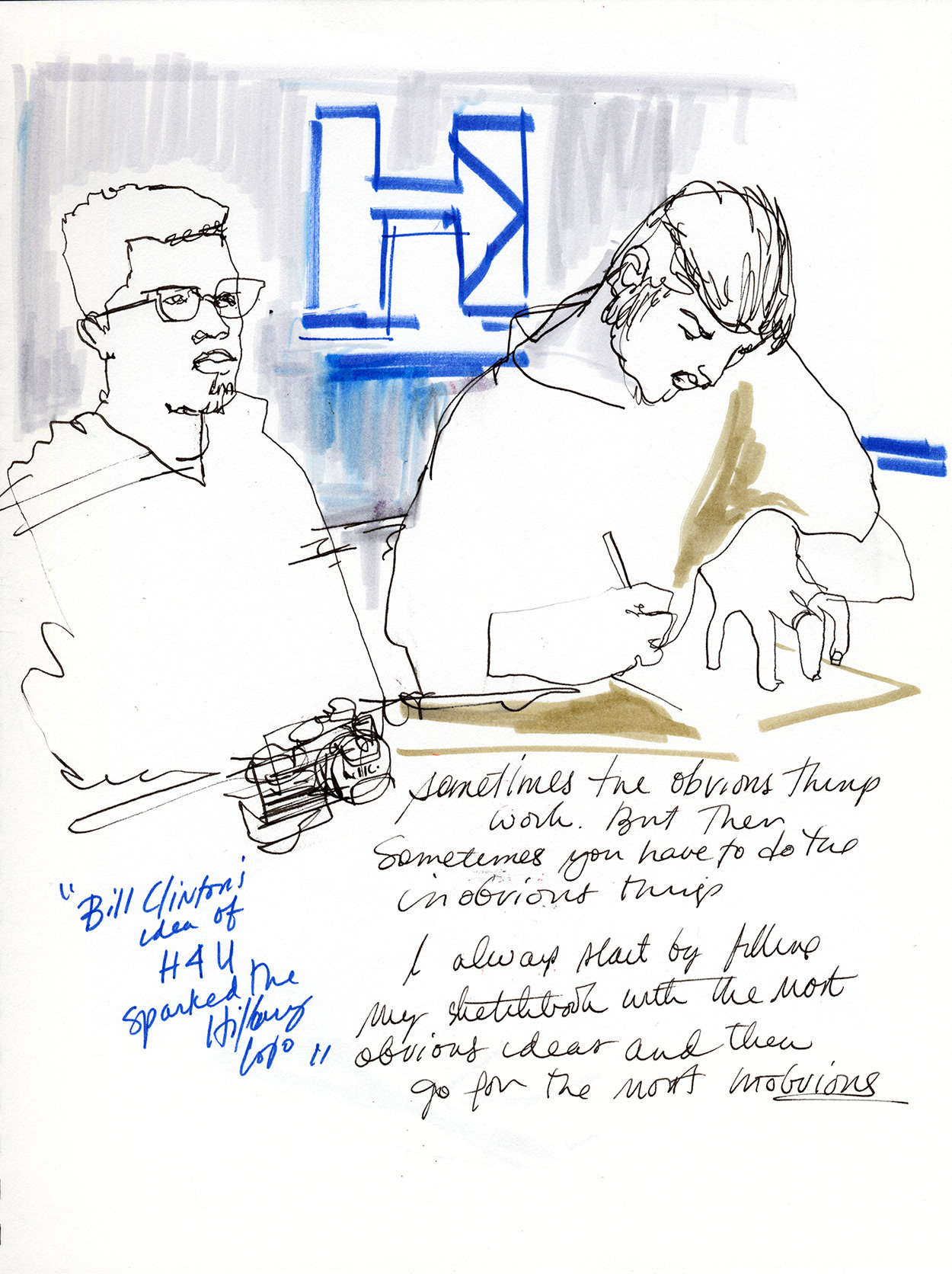
The students were very interested in what Michael Beirut was saying, taking notes and asking follow-up questions. He was so generous with his time for the kids, and genuinely interested to know how he could best advise them for their future careers. At the end of the meeting, he took us on a quick tour of the design firm. Such a gentleman!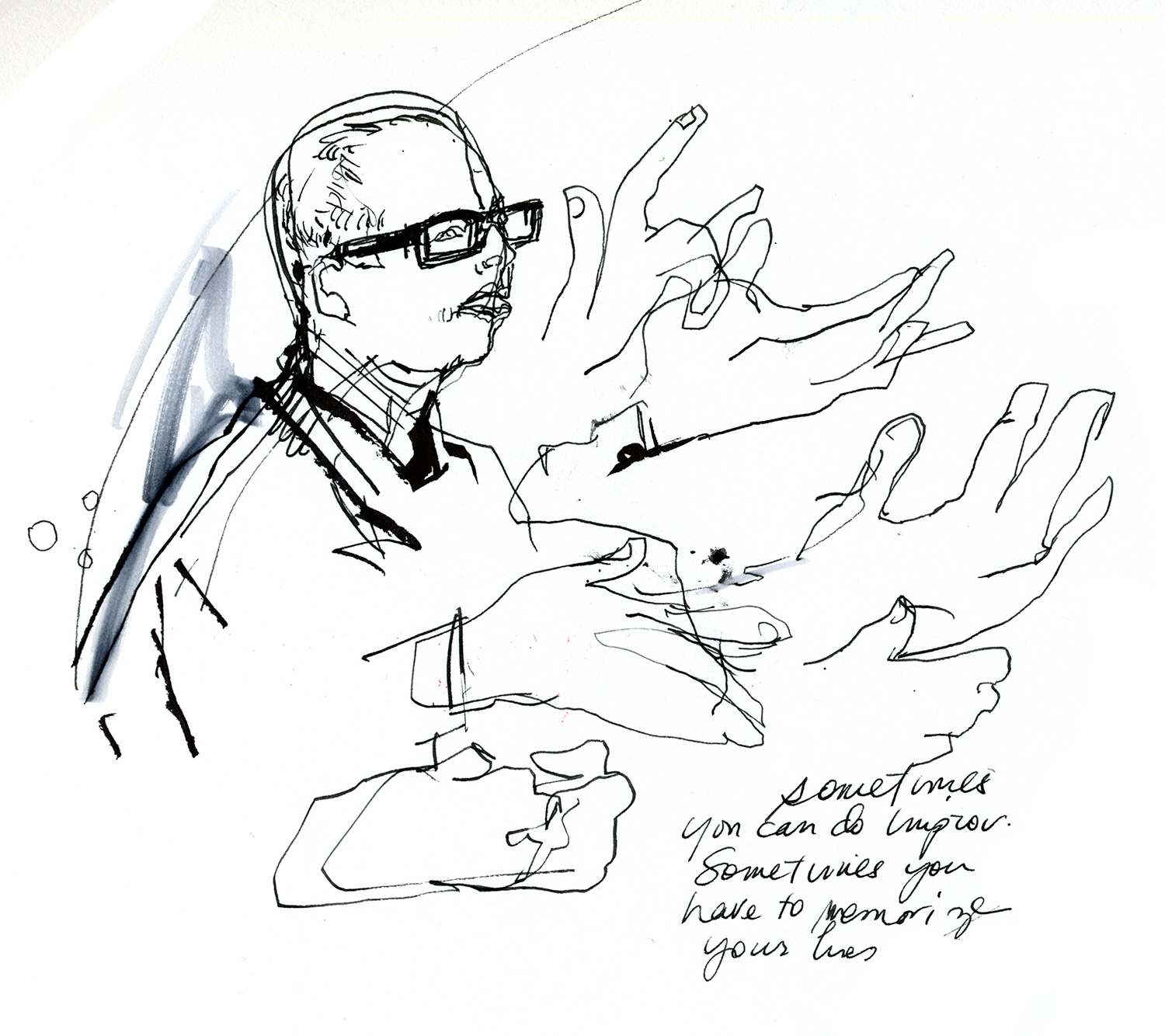
Michael Beirut summing up Creativity and Design: “Sometimes you can do improv,” he said, “sometimes you have to memorize your lines.”
Such a wonderful start to our tour! But there was no time to waste – we had 20 minutes to get down to the West Village, where we had our next appointment with designers Stephen Doyle and Gael Towey. A married couple who have spent their lives in design and creativity, they live in an enviable brownstone in the West Village of NYC, with their offices on the garden floor. Wow! Such a warm and down-to-earth couple, they had snacks on hand for the kids, laid out along a long wooden conference table. But first, a quick tour of the design offices and the (rainy) garden in the back. Stephen had a mosaic picture that he wanted the students to decipher – – “Can you see it?” he asked in a mischievous way, “it’s Sigmund Freud smoking a cigar!”
Then we went into the conference room, with it’s floor-to-ceiling shelves filled with books, Stephen’s paper sculptures, and all manner of interesting bric-a-brac. He showed a film overview of the work of Doyle Partners, and talked about how important it is to play and enjoy what you’re doing, and how it’s even more important to take chances while you do it. Safe isn’t the answer.
“My design work”, Stephen said, “is about solving problems. My sculpture is about creating them.”
Stephen showed us many unusual visual solutions for publishing, magazines, branding and identities, and spoke of the importance of storytelling and a sense of community for designers. My favorite pieces were his sculptural ones, especially the book sculptures – strips of text from books that he twirls and molds into interesting shapes. I also loved his twig type treatment for the cover of “The Druid King.” Talk about the importance of follow-through: no idea was half baked, or half completed. It was inspirational to see all of it. The students were enraptured, and also, enjoying their snacks while they listened. :)
It was all about the IDEA, but also, fulfilling the potential of that idea without short-cuts. As Stephen spoke, Gael interjected here and there with her perspective on the topic. Then, she got up to present to the students.
Gael talked about Martha Stewart Living magazine, that she helped launch in 1990, and how she stayed on as Creative Director. Her role, as she described it, was about making things not only beautiful, but also simple and accessible enough for people to do themselves at home. Not a simple task! Then Gael got a little more personal, talking about what her next steps in life were, after stepping away from the company after 22 years. “How do you re-invent yourself?” Gael asked. “How do you unleash the creativity in yourself?” Her own answer came by following her love of storytelling.
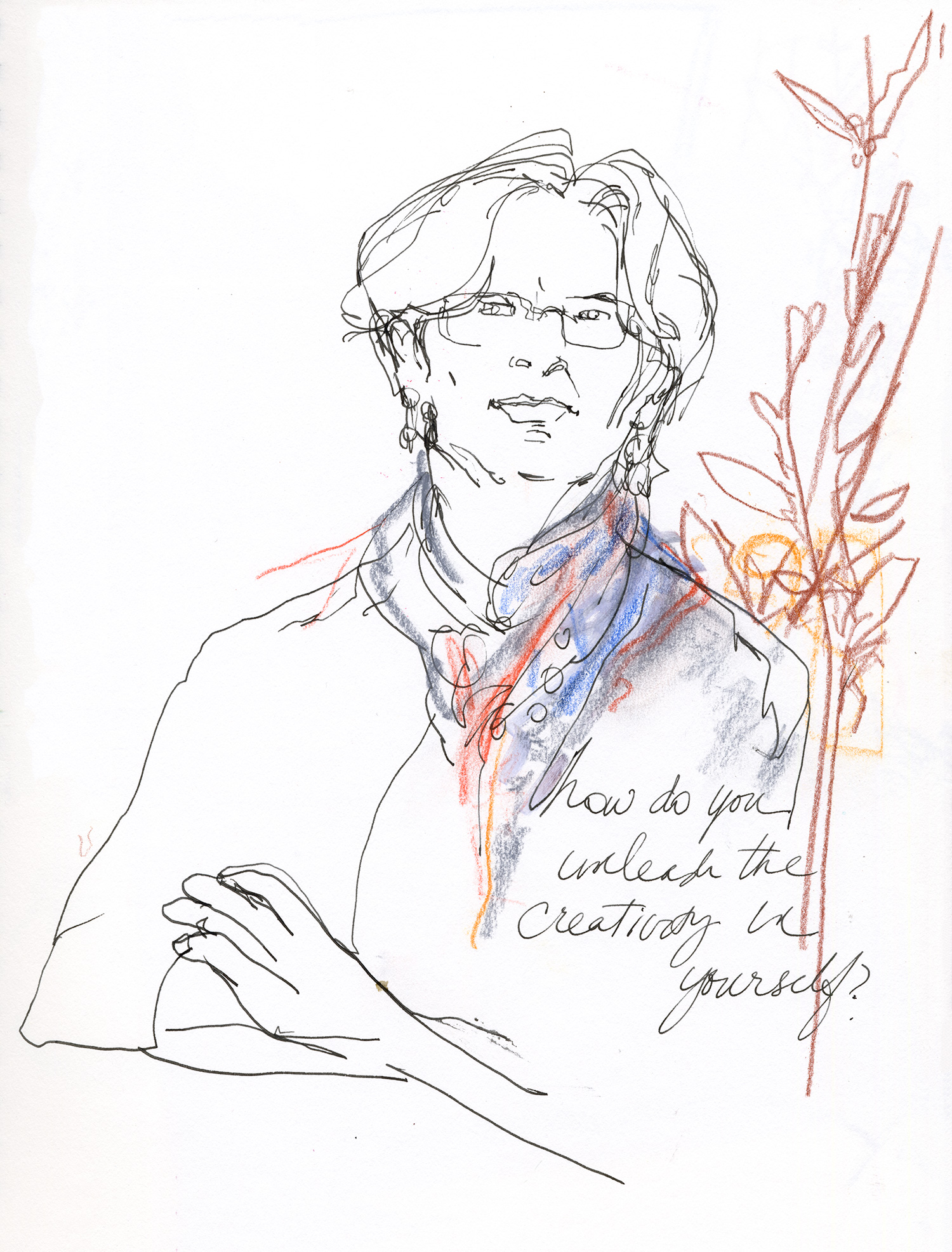
Gael founded Gael Towey & Company, a company through which she produces and directs short-form documentary videos on exactly this topic: Portraits in Creativity. She interviews creative people and finds out what makes them tick. “They all said the same thing” she told us, to follow your instincts and take risks; an echo of what Stephen had said a few minutes earlier. We saw several excerpts from her films, including one of her friend Maira Kalman, who we planned to visit later that day.
But before we left, Stephen wanted the students to see his company’s current project: an animated logo for The Moth which they had presented to the client earlier in the day. “Now,” he said, “logos have to come alive on screen,” and he wanted to impress that on the kids. The students loved seeing the digital work in progress, and peppered Stephen’s designer with questions while he consulted with another designer about the next steps. The atmosphere at the 25 Perry Street offices was warm and inviting, and the love that both Gael and Stephen have for what they do was contagious. I could have hung out there all day, but it was soon time to go on to our next visit.
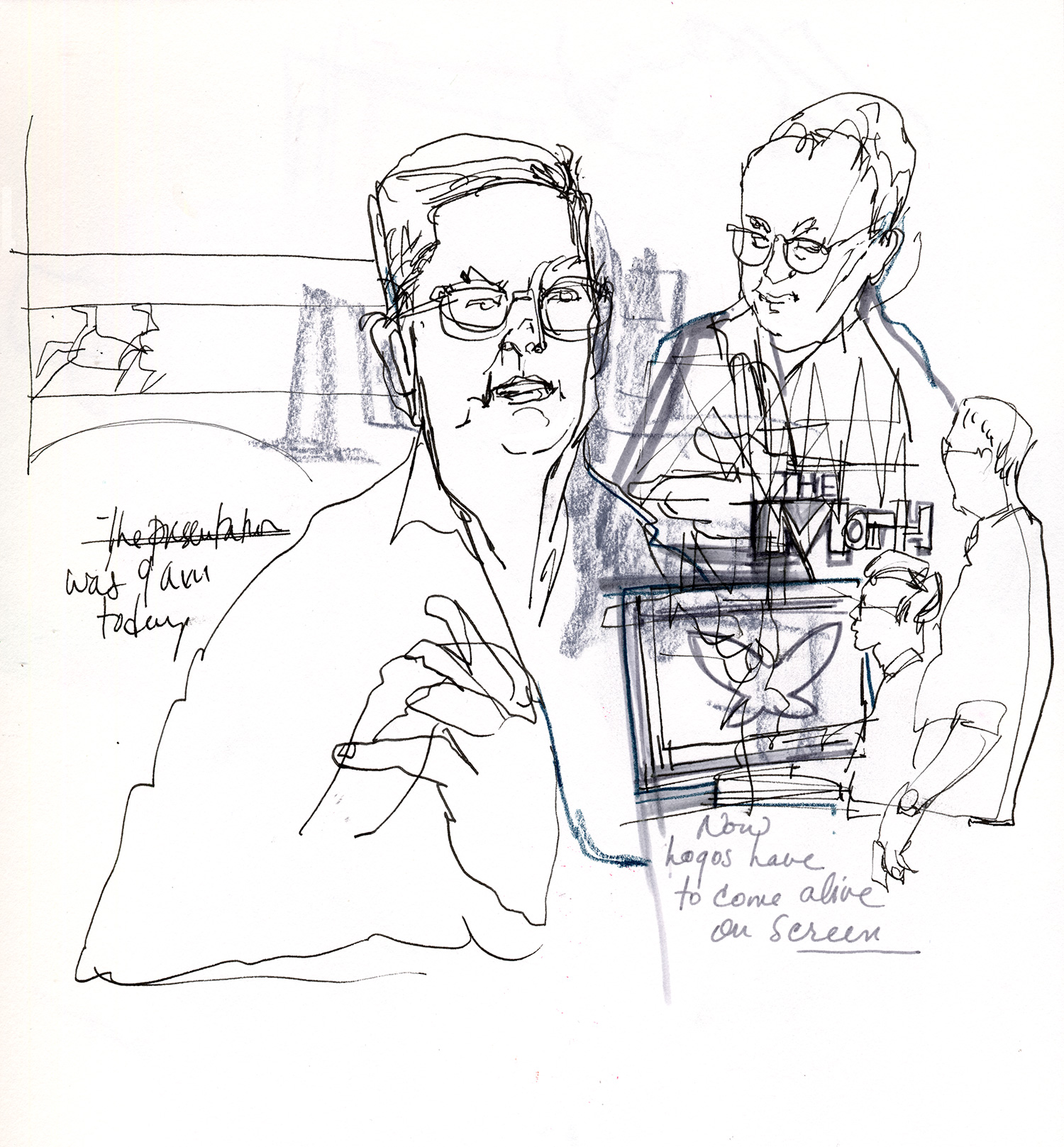
After a quick stop at Murray’s Bagels on 6th Ave (I’ve never ordered 9 separate bagels with toppings there in my life!) we were walking to our next appointment, with the illustrator Maira Kalman. I am a big fan of Ms. Kalman’s work, and was especially looking forward to listening in on her conversation with the students while drawing the proceedings.
“If you don’t follow your instincts you will do nothing in this world.”
Maira Kalman’s first statement was an echo of what we’d just heard from Stephen and Gael. No wonder they were friends. Maira went on to clarify what she’d just said, telling the students that this didn’t mean they couldn’t have a career or find happiness, but that if they didn’t listen to their own instincts, they would not do that thing that they were uniquely qualified to do. What great advice! Then she talked about how there are all kinds of people in the world: Not everyone is creative, not everyone wants to break the so-called rules, but there is room for everyone, and actually, a need for all kinds of people to work together. So absolutely true. I knew I liked her work for a reason, ha ha. So sharp and intelligent, quick, and very interested in the students, it was a pleasant and informal discussion from the start. The students were especially relaxed with her, perhaps partly because she had welcomed us into her home, and we were sitting casually around her beautiful living room.
Her apartment felt like an extension of her art: there were little dolls lined up on the mantlepiece, interesting curios from around the world, a hat collection, lace doilies, silver candlesticks, photos of her beloved mother, and cherry blossom stems artfully arranged in a tin bucket on the table. One of the students asked Maira about the famous idea of a “work-life balance” and her answer was a wonderful illustration of the artist’s life: “I want my life to be my work.” She described how she followed her instincts and filled her days with the things that interested her, which then seemed to become interesting for others as well. This included her travel and the things she looks for when traveling, and her love for her mother, who wore only white, which led to an art exhibit of her mother’s closet. Amazing.
 “I fall in love 1000 times a day,” she told them.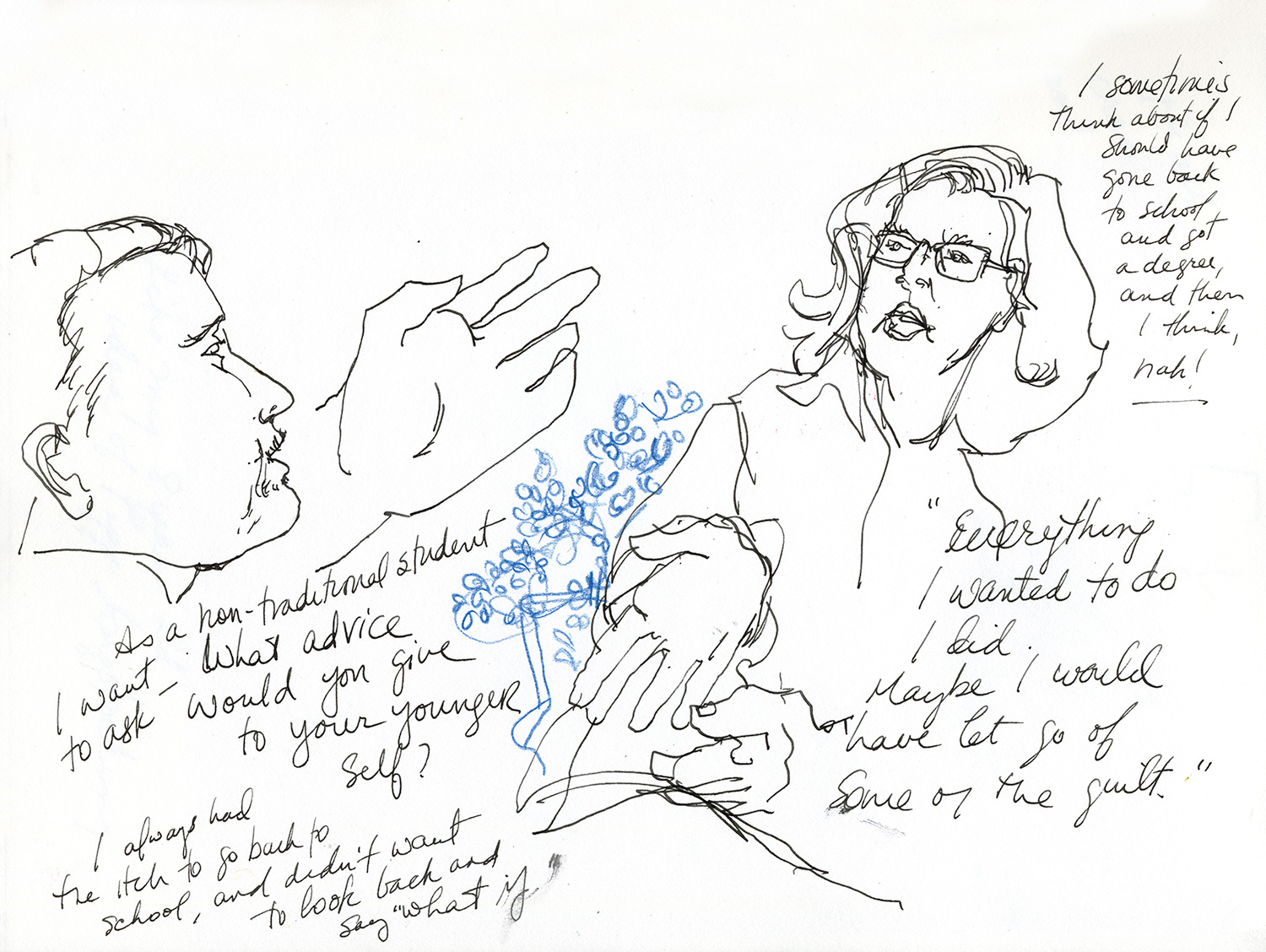
As Maira continued to talk about following your own path in life, she seemed to strike a chord with one of the students in particular, named David, who had returned to school after a hiatus of a few years. He wanted to know, “as a non-traditional student, what advice would you give to your younger self?” Maira’s answer fell right in with what she had been saying since we arrived: “Everything I wanted to do, I did.” Great advice for people just starting out in life, including (I might add) the still-quite-young ‘non-traditional’ student. I felt very happy listening to her. She talked also about her eight-year-old self, who was so enamored of Pippi Longstocking and her independent way of thinking, and how that had influenced her life. I’ve always felt too that you never really change too much from your eight-year-old sense of what is important in life, and Maira Kalman is a great example of how to fulfill that promise to yourself.
Maira ended the conversation with the four rules of life that she learned from Laurie Anderson and Lou Reed: 1. Be Gentle – Be Tender  2. Don’t be Afraid of Anyone  3. Have a Good Bullshit Detector and 4. – what was four? One of the students googled these rules and found that there were only three. Maira laughed – “no wonder I couldn’t remember number four!”
 The atmosphere was so warm and inviting in Maira’s place, and there was a long wall of bookshelves that I suspect we could have spent days perusing, but soon enough it was time to move on to our last interview for the day: downtown to visit the architect James Biber. By the way, all of the people we had met today were friends – of course. As my mentor told me a long time ago, the definition of talent is recognition of talent in others, and these are some extremely talented friends.
James Biber is the principal of the company that bears his name: Biber Architects. One look at the company website and you can see that this is an eclectic and inquisitive firm. The first line of their “about” section reads: “Every building is a biography.” Yes. And James Biber is an interesting author of that biography. He took the students on a video tour through several of his firm’s projects and ideas, including a series called: 100 ideas for New York. Talk about designers engaging with the world – James brought us back full-circle to some of the things that Michael Beirut had been talking about that morning, and it was not surprising to hear that from 1991 to 2010 James had been a partner at Pentagram, as the first architect in their New York offices.
Today Biber Architects is, according to it’s website, a “design-led architectural firm.” And the inspiration, says James, “comes from the clients.” Again, that idea of listening.
He also echoed some of what we’d heard from Stephen Doyle, when he talked about the balance of one’s work and life. James Biber described life as “a delicate balance between order and dis-order.” It’s a back and forth, with an open mind and a curiosity that makes the creative person tick. James had a lot of words of inspiration for the students, and said to them that no one springs fully formed into this world: “Everyone remembers being in your position…it can be daunting,” but reminded them that we can all learn from each other, in fact: “teachers learn more than you do.”
Well said, and I was certainly taking notes along with the students!
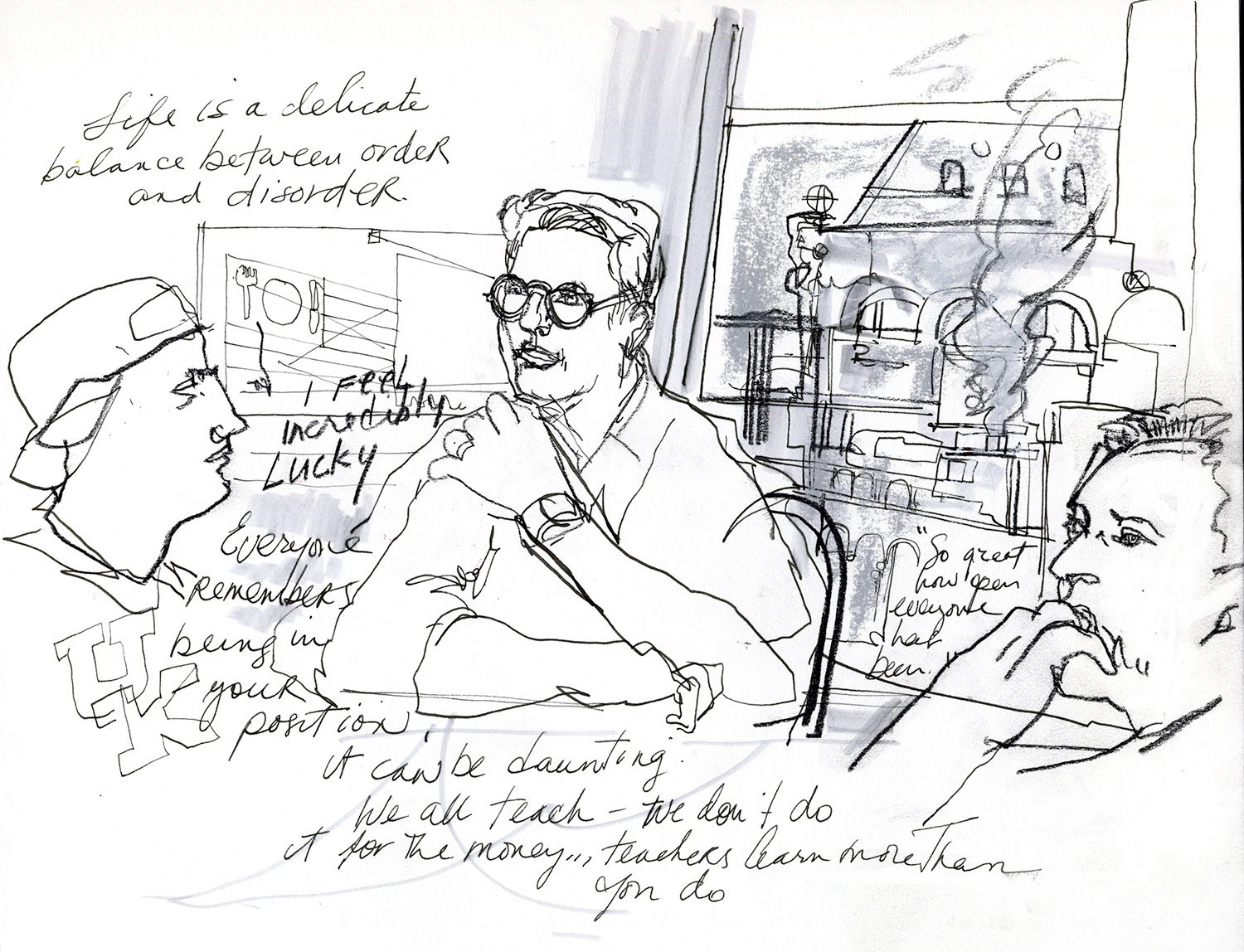
As James talked about his life and his projects, the idea of gratitude came up for him again and again. Gratitude to be able to live the life he wanted, to be creative, and to feel fulfilled in his work. He definitely loves what he does, and as I listened to him talk, and saw all of his projects, ideas, sketchbooks, and doodles on the screen, the word CURIOSITY kept coming to my mind. Asking questions and saying ‘why not’ seems to be the secret to a happy and fulfilled creative life, not only for James Biber, but for all of the people we had met that day.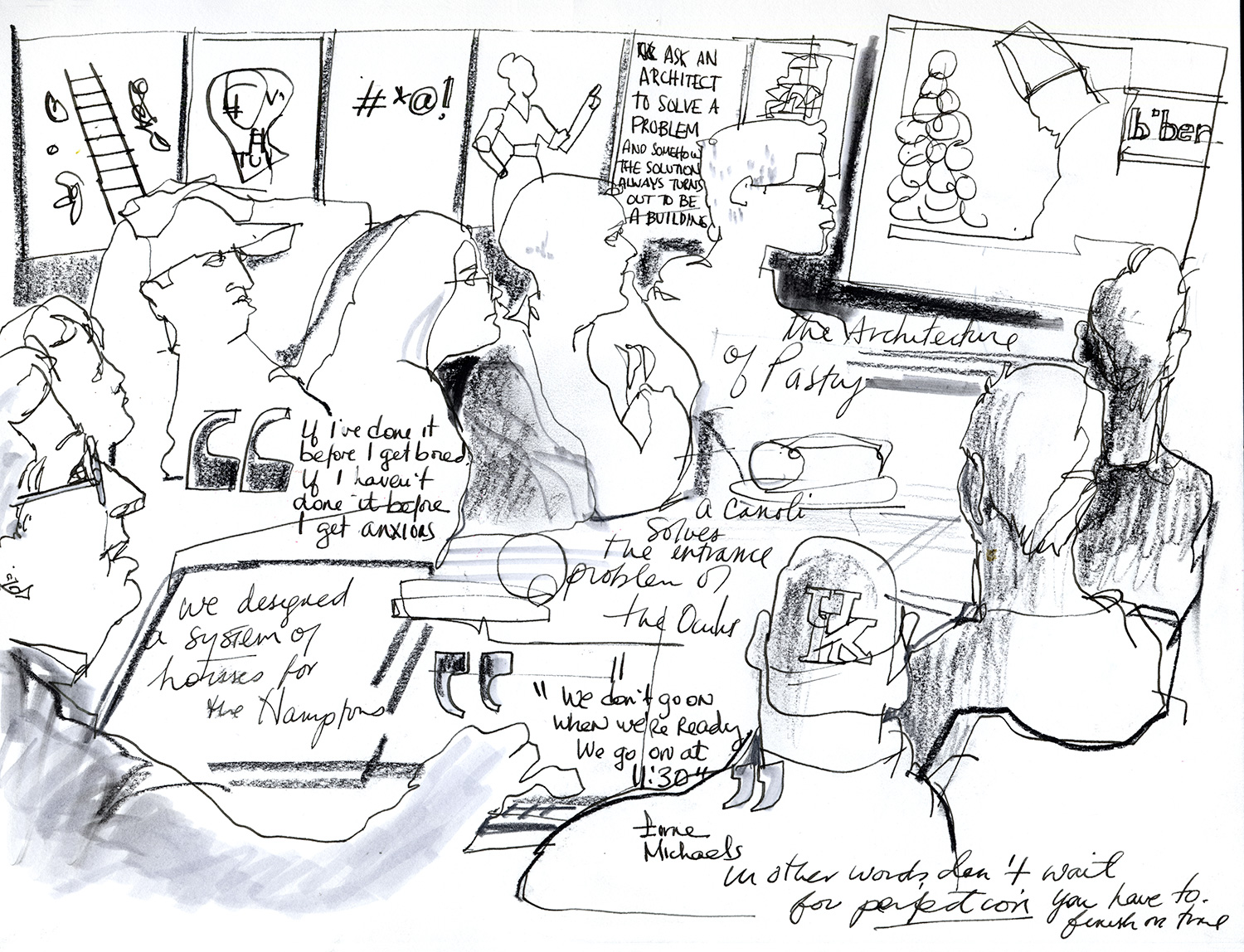
I particularly like how the drawing above came out: showing everyone around the table, surrounded by the messages of Biber Architects, watching a video of projects they’d completed, and the inspiration for those projects. One of the students, Connor, came up to check out the drawing after the fact. “I knew you were getting everyone!” he said happily. I did want to capture everyone, in this last drawing of our last meeting of the day. Metaphorically, I saw the illustration as encapsulating the day we’d just had: Jacob, David, Rakeem, Amanda, Justin, Joseph, Connor, Prof. Ryan and of course, myself, all surrounded by these words of encouragement and practical wisdom. James Biber said something that everyone else we’d met that day said as well: “I feel incredibly lucky.” But it seemed to me as I listened to them all, that they had made their own luck. They illustrated well the famous Seneca quote, that luck is simply “what happens when preparation meets opportunity.”
I felt incredibly lucky as well to be doing this reportage, and to be a fly on the wall for so many uplifting conversations and life stories. It was an amazing day of insight, and we were only halfway done with the Study Tour! I could see that the students were very inspired by the visits we’d had, but I had been very inspired as well.
Michael Beirut on the importance of participating in the world, listening to what’s out there and making a contribution; Stephen Doyle on creating work that solves not only the client’s problems but your own need as an artist to play and explore; Gael Towey on how to follow your creative urges even if it means re-inventing yourself after a successful 22 year career; Maira Kalman on being the true to your own instincts and feelings about what is worthwhile and interesting in life; and James Biber on curiosity and the importance of gratitude in life and work.
We left Biber Architects and took a walk over to the Oculus and the World Trade Center memorial. We walked solemnly around the memorial, and talked about September 11th, and the many men and women whose names we read there. Several of the students told me personal stories of where they were on 9/11, and I told them about how I’d been there drawing the events, documenting the change of our world history as it happened. I brought them to see the ‘survivor tree’ and we bonded, as artists, Americans, and world citizens. It was a fitting way to end the day.
And as we walked around the Oculus and the World Trade Center Memorial, I could feel everyone reflecting on just what a special day it had been. All of these creative people had been so giving with their time and their stories: generosity of spirit like that was such an antidote to the kind of terrible violence that happened on 9/11.
The sun came out from behind the day of rainy clouds and shone brightly, as if to confirm those feelings. I said goodbye to the group and hopped on the subway heading home, to re-charge and prepare for the next day.
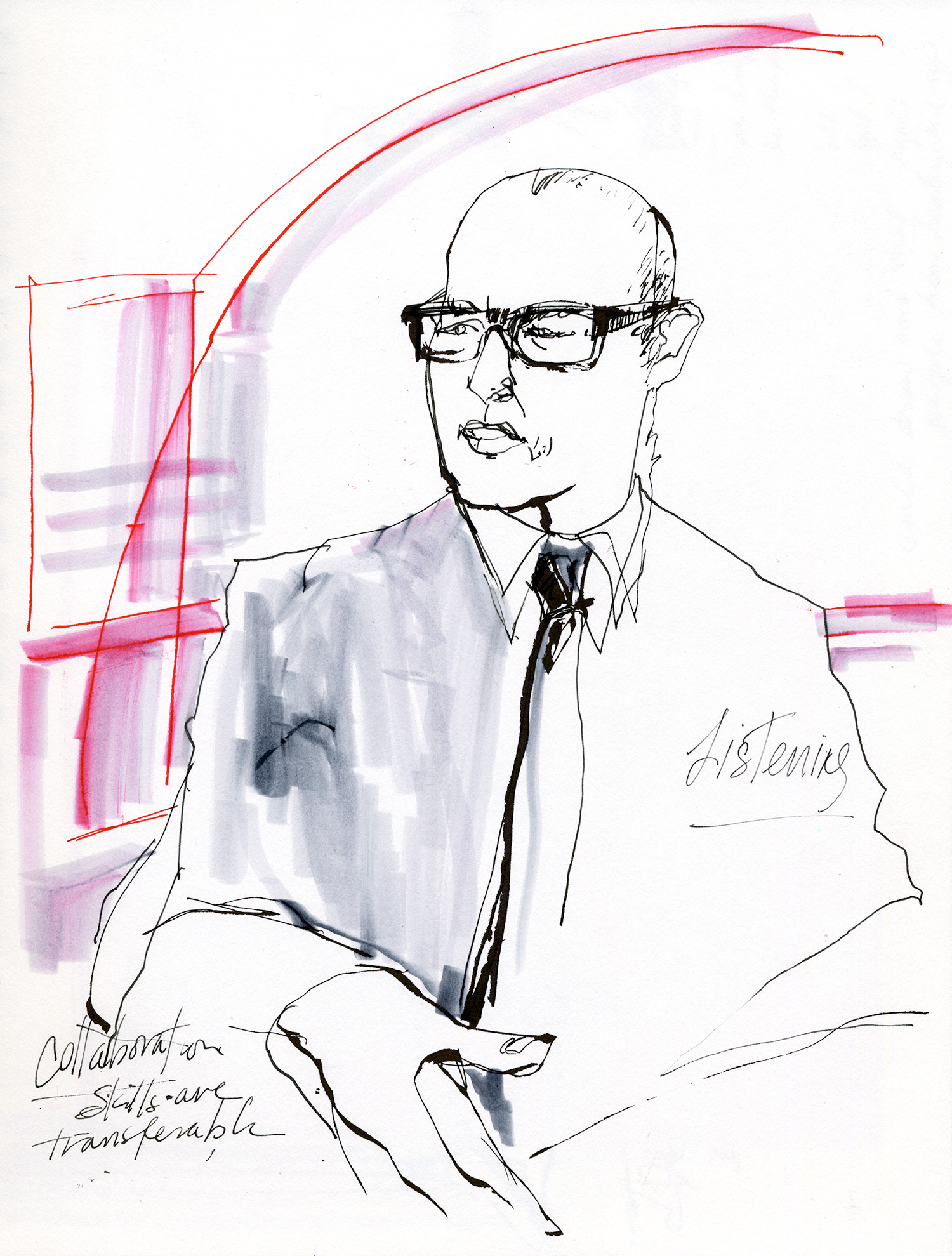
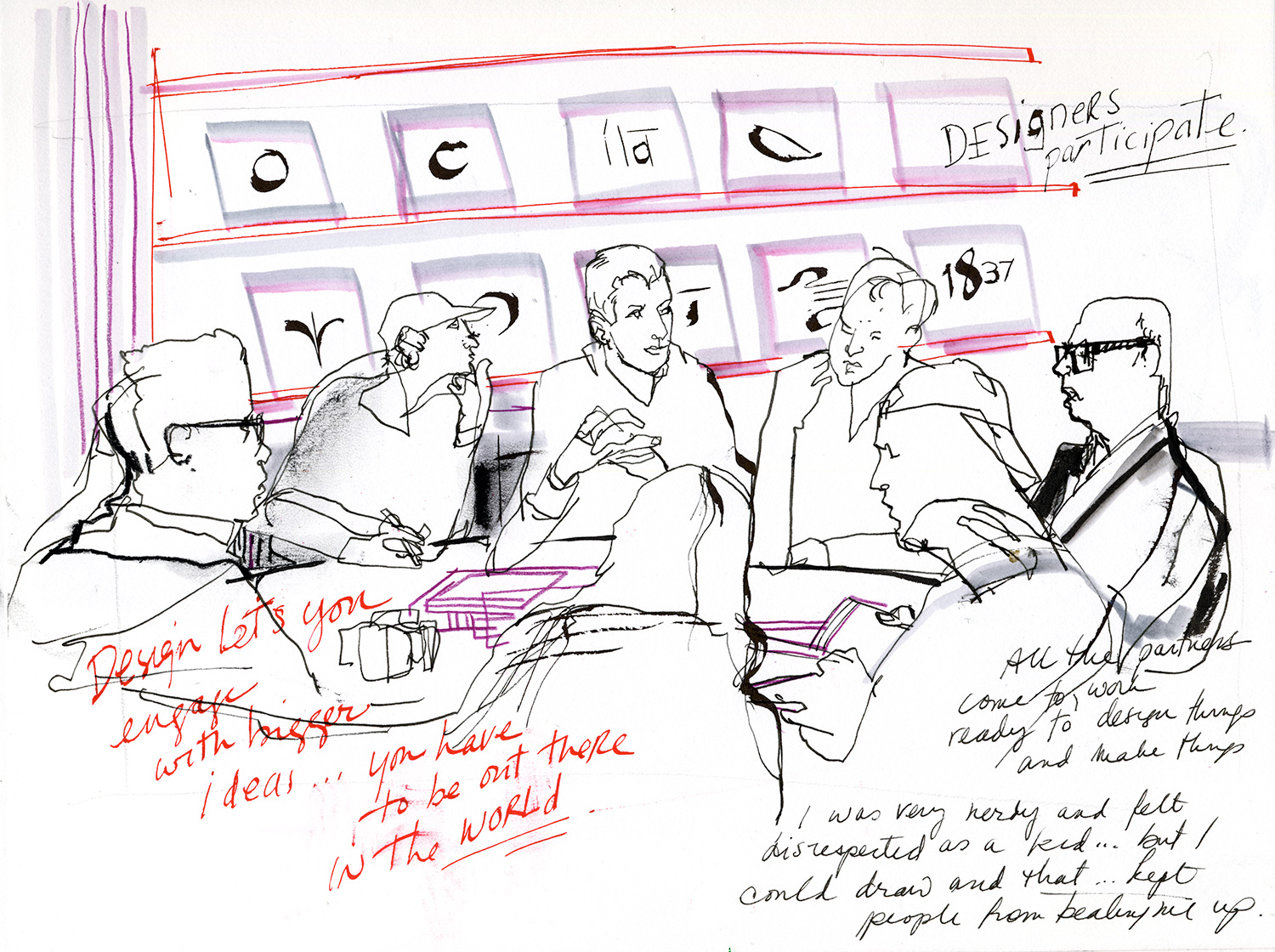
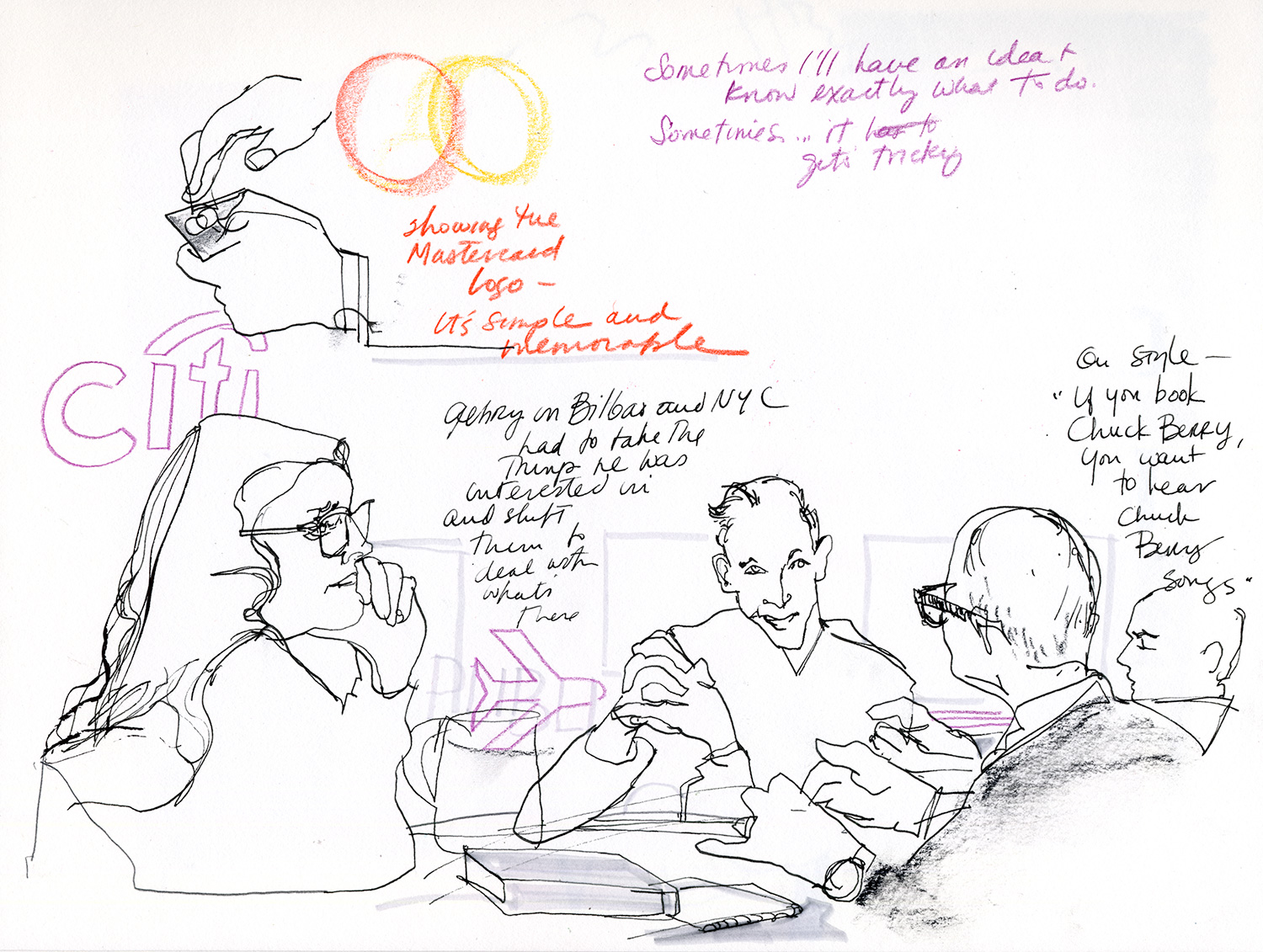
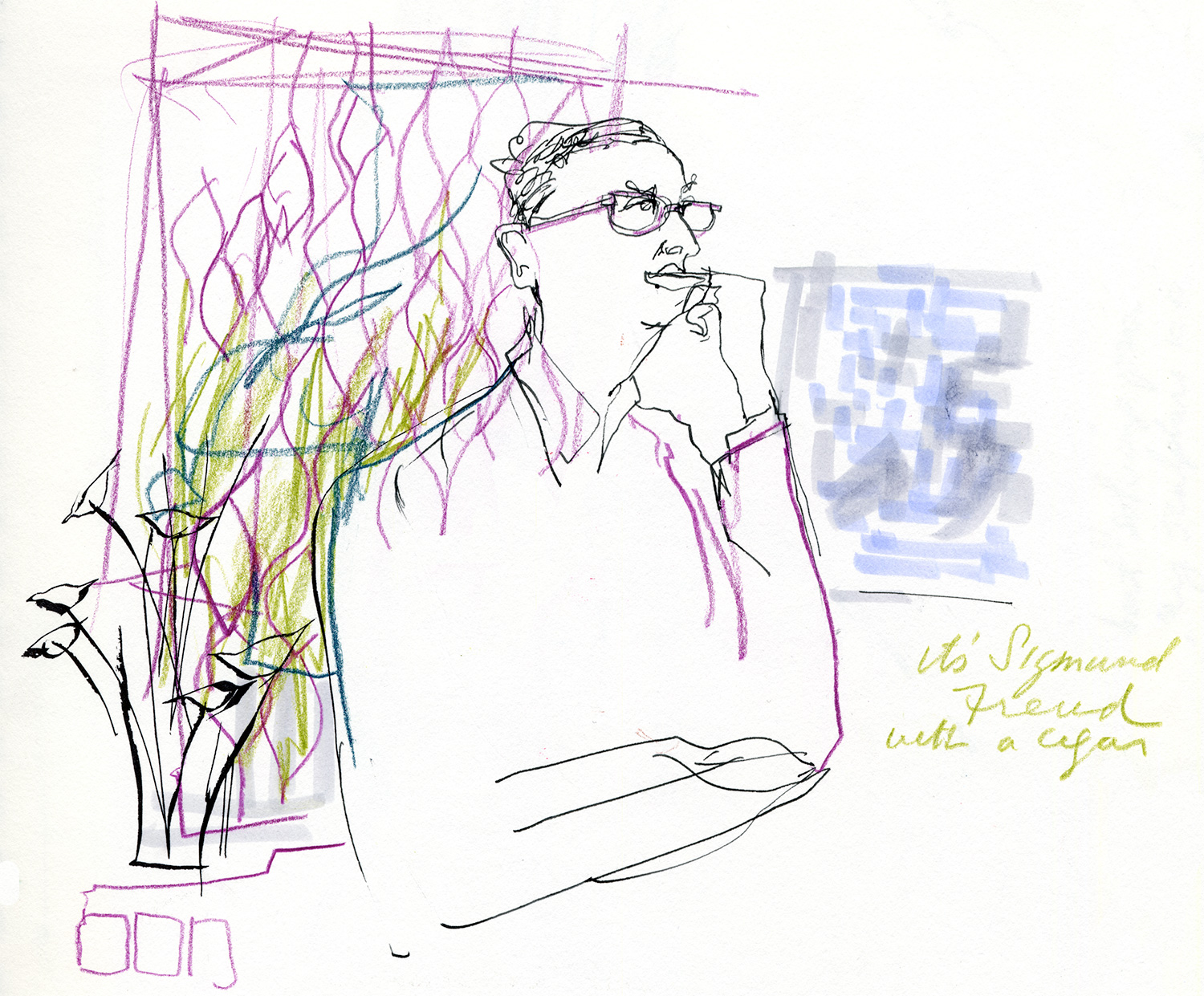
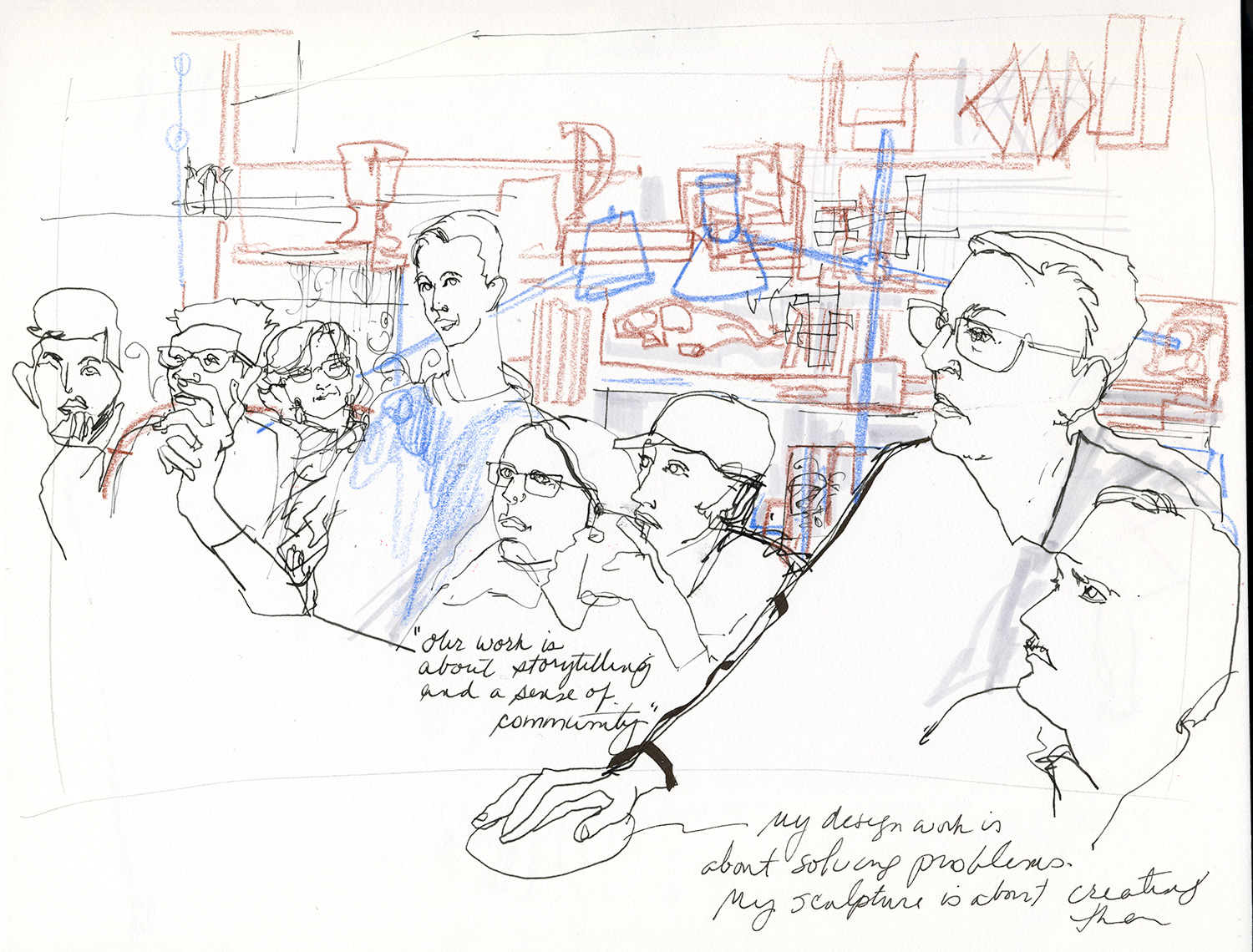
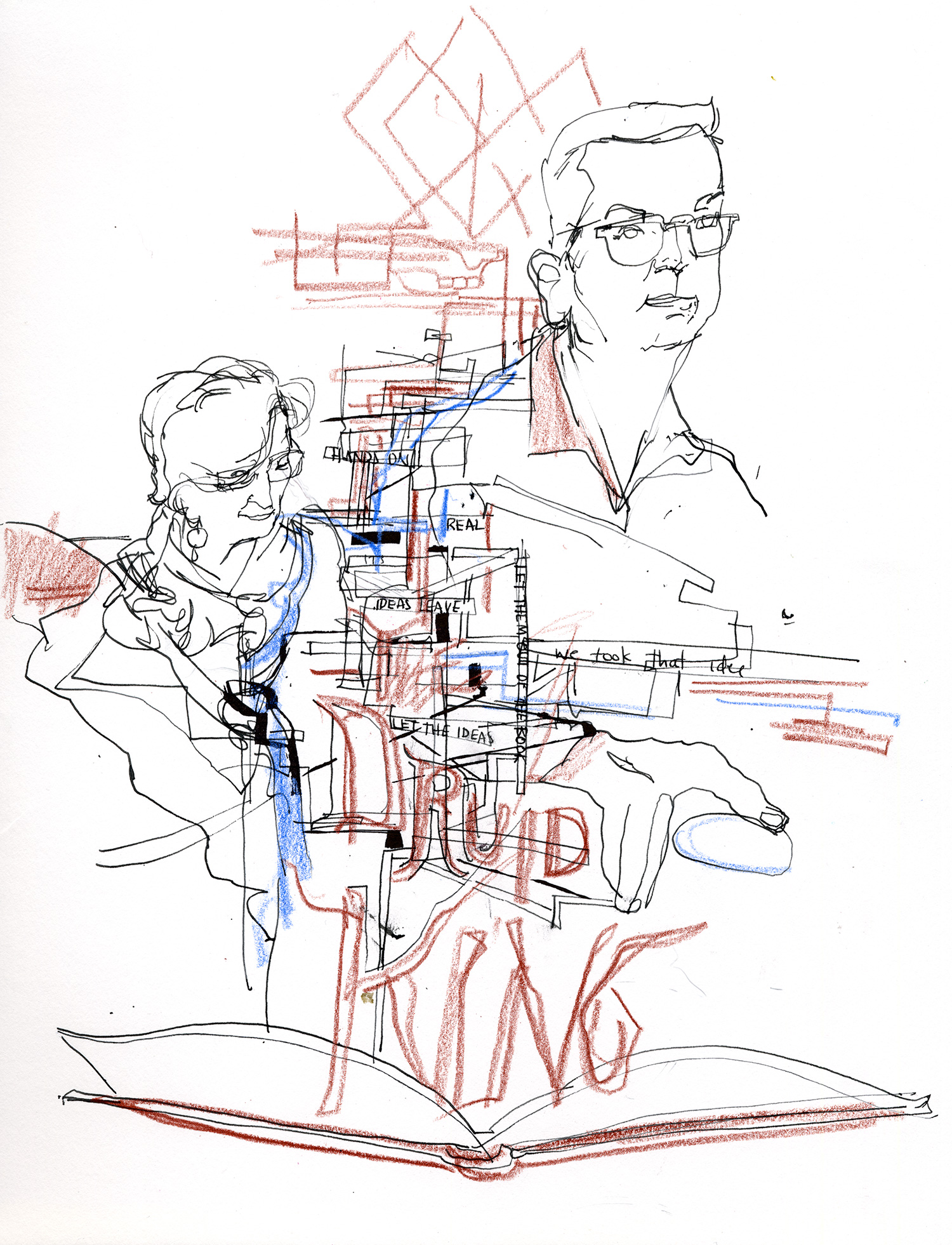
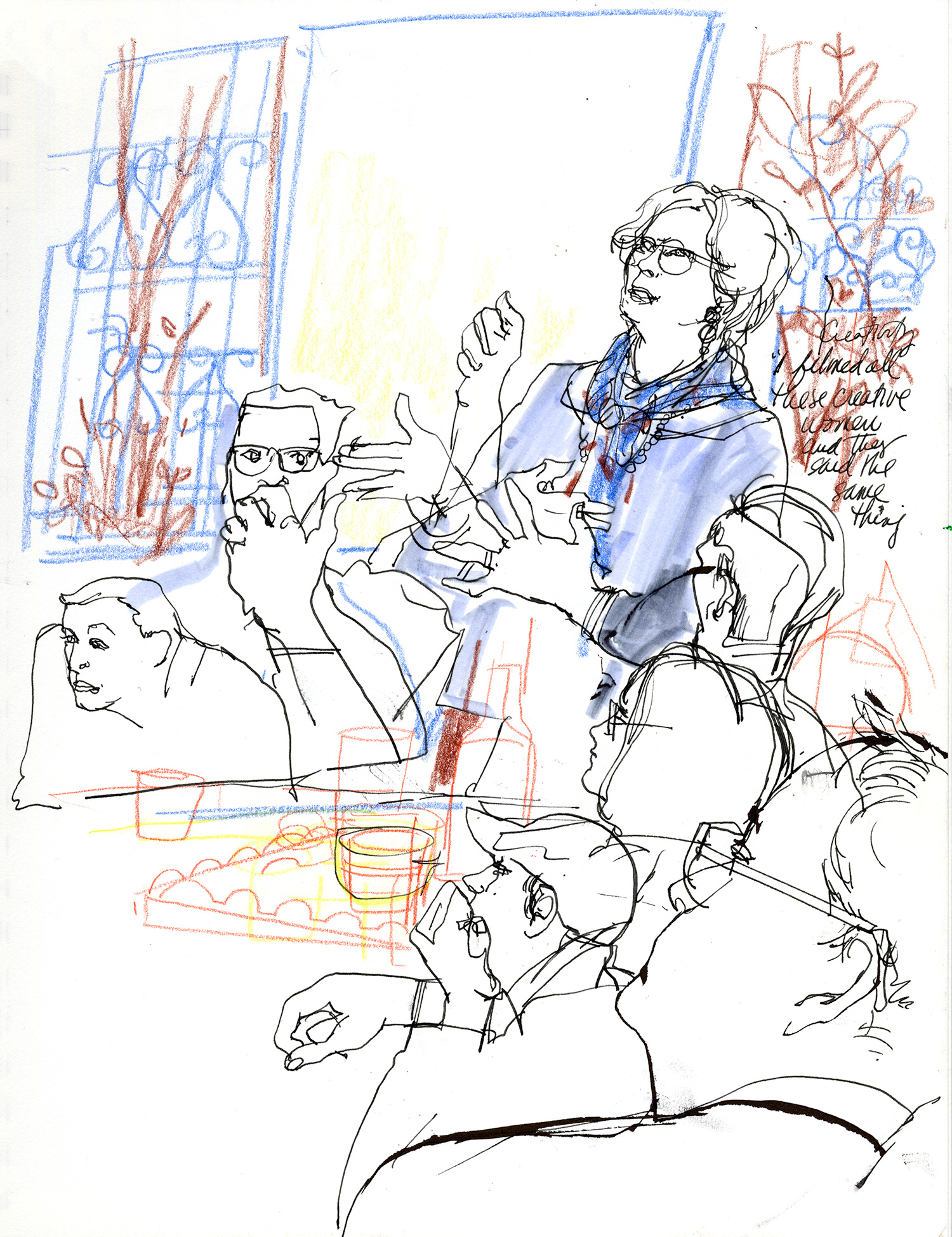
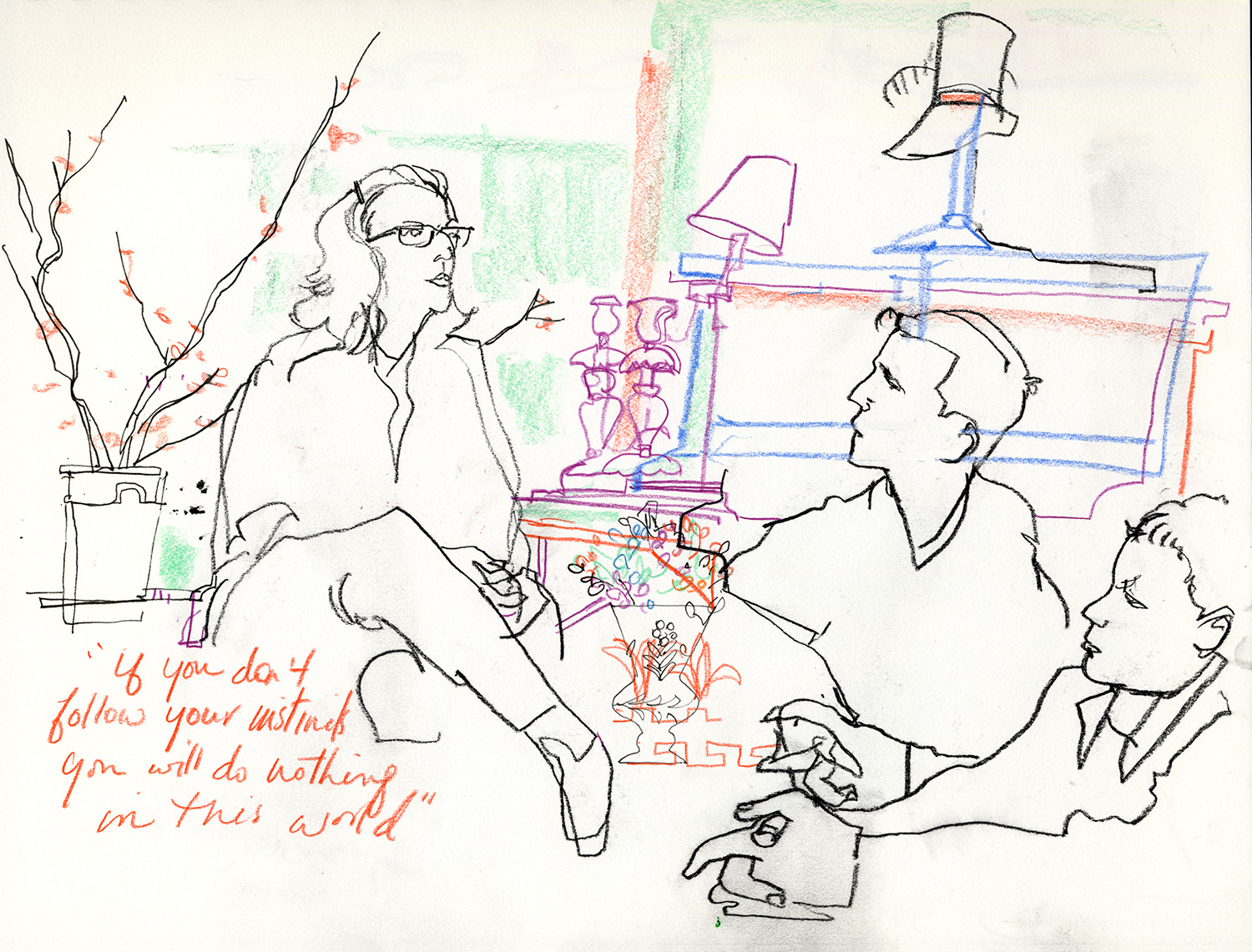
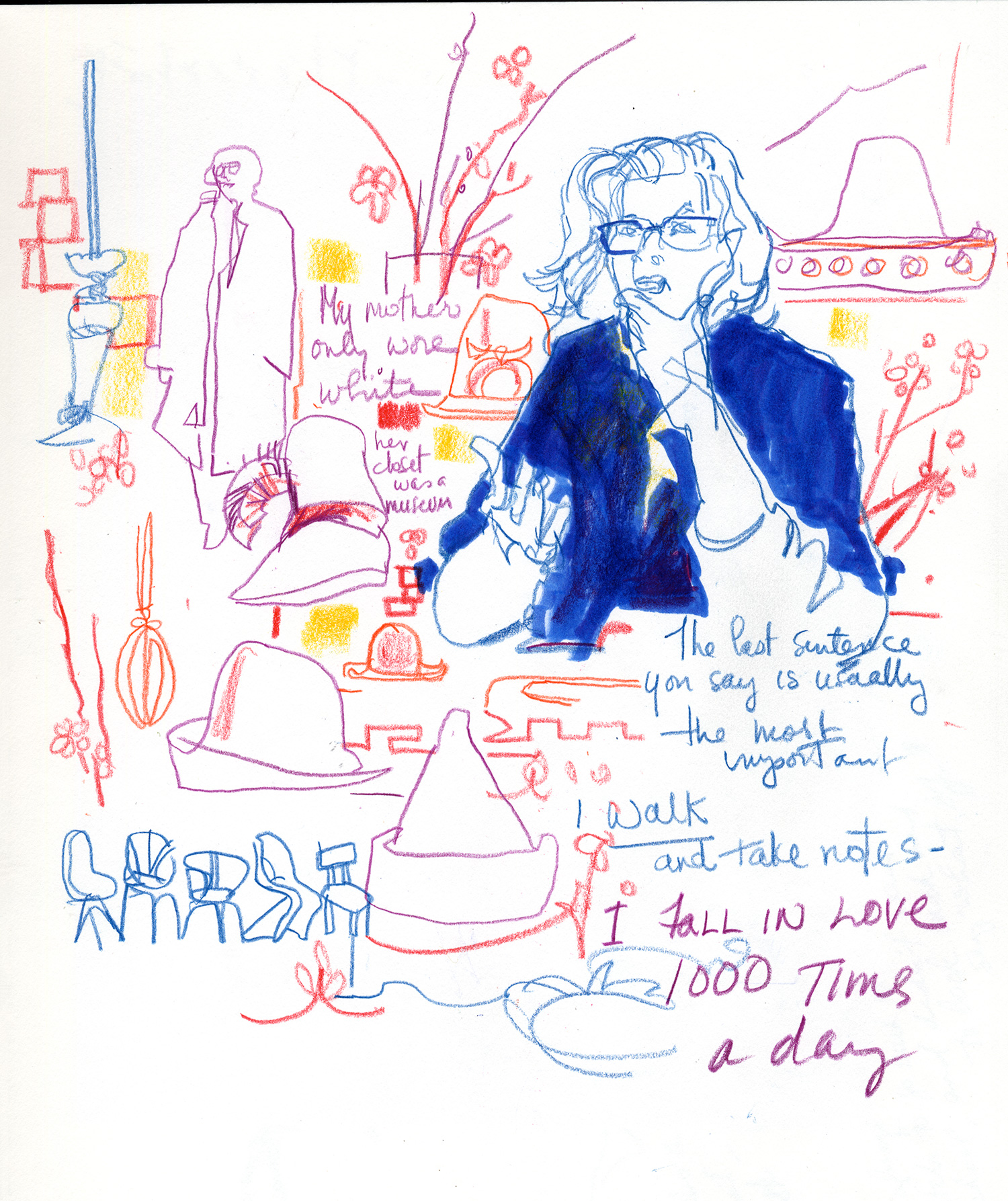
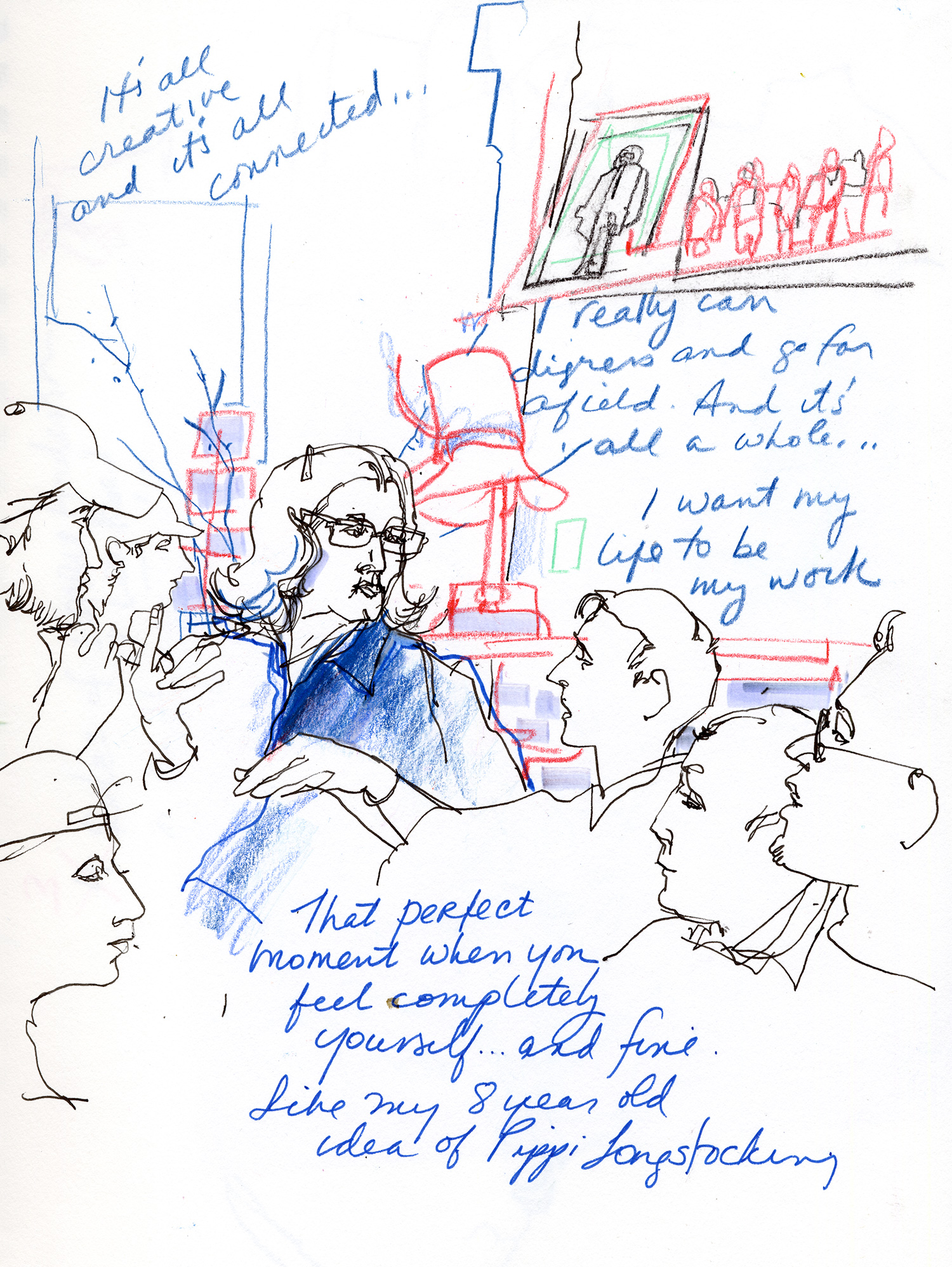
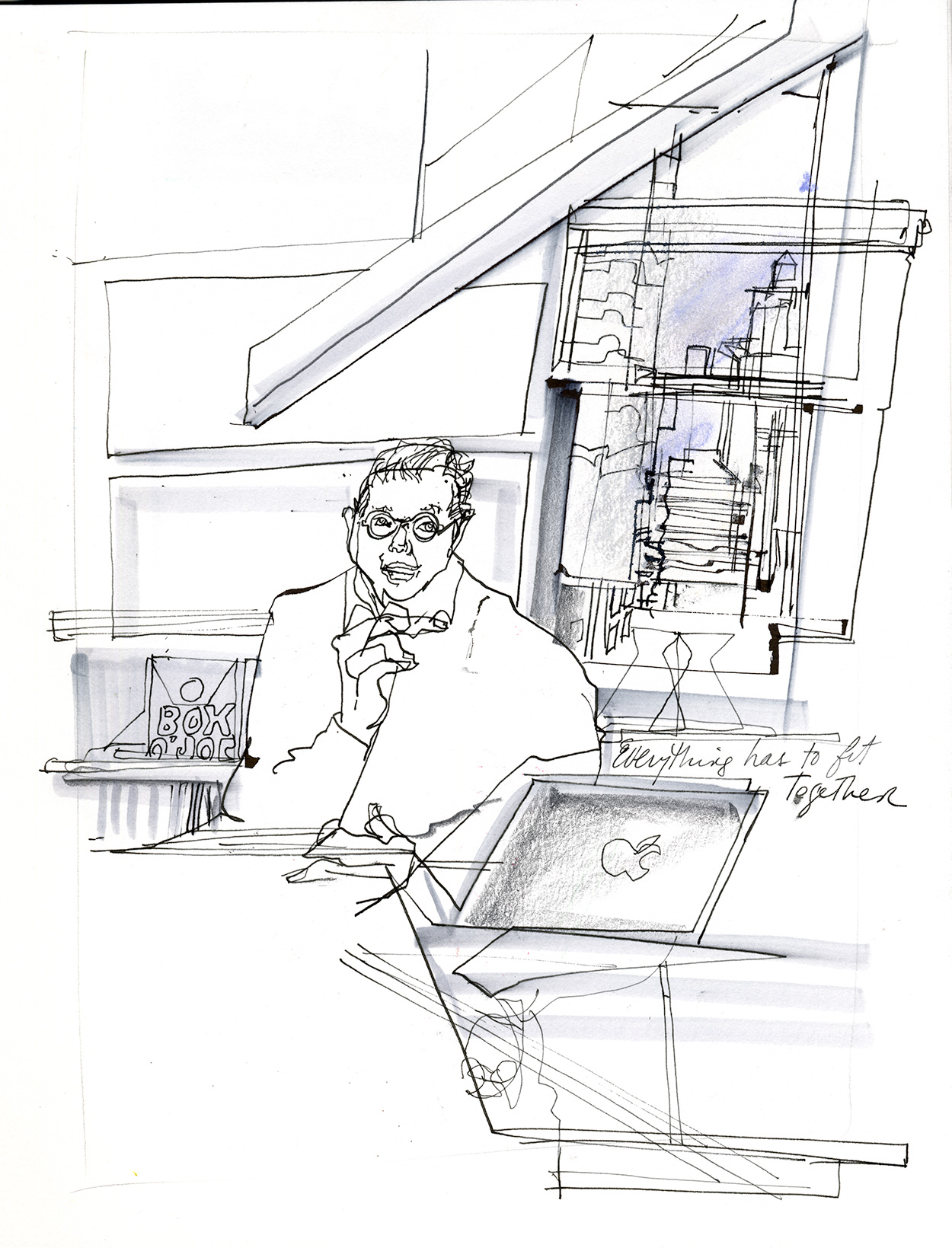

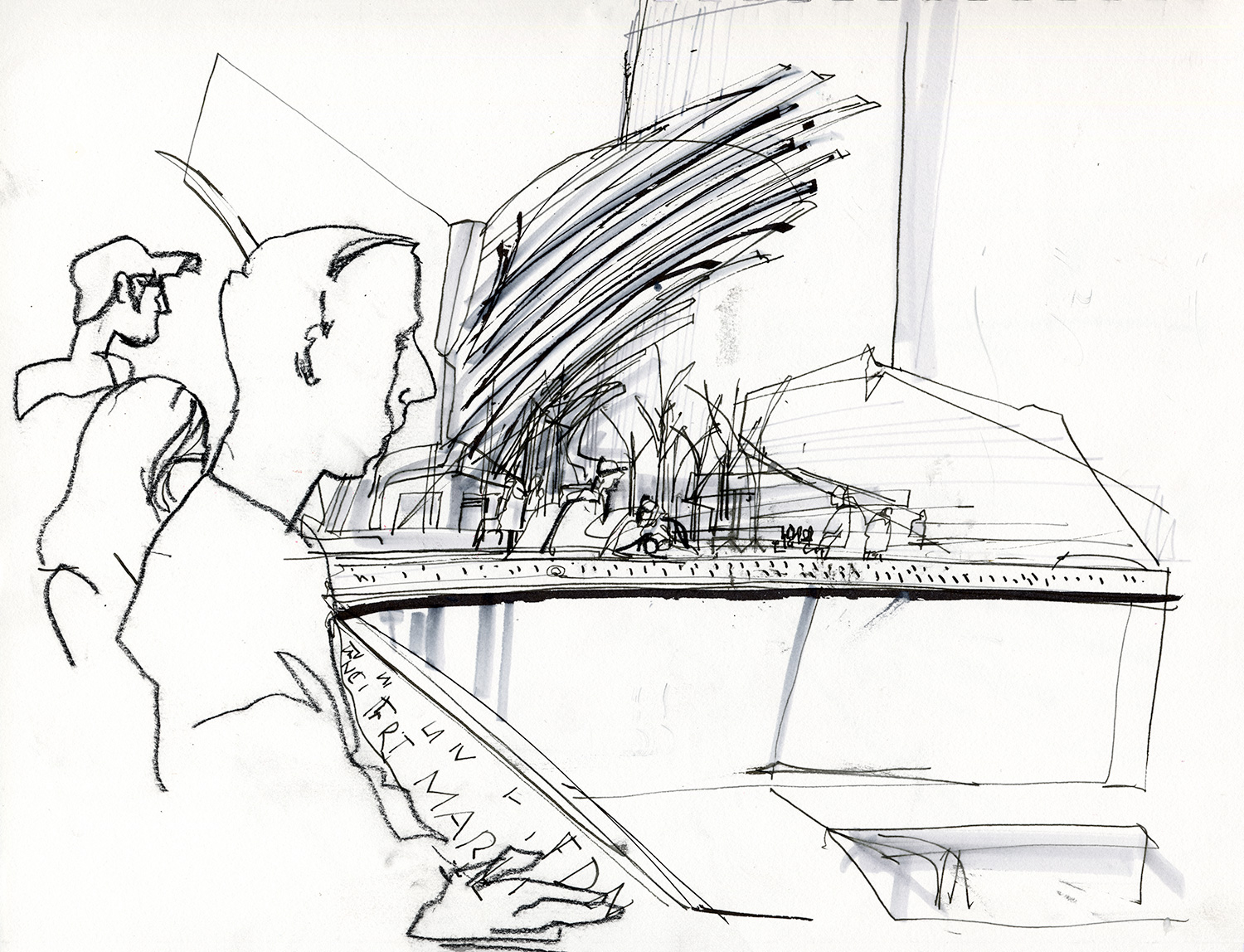
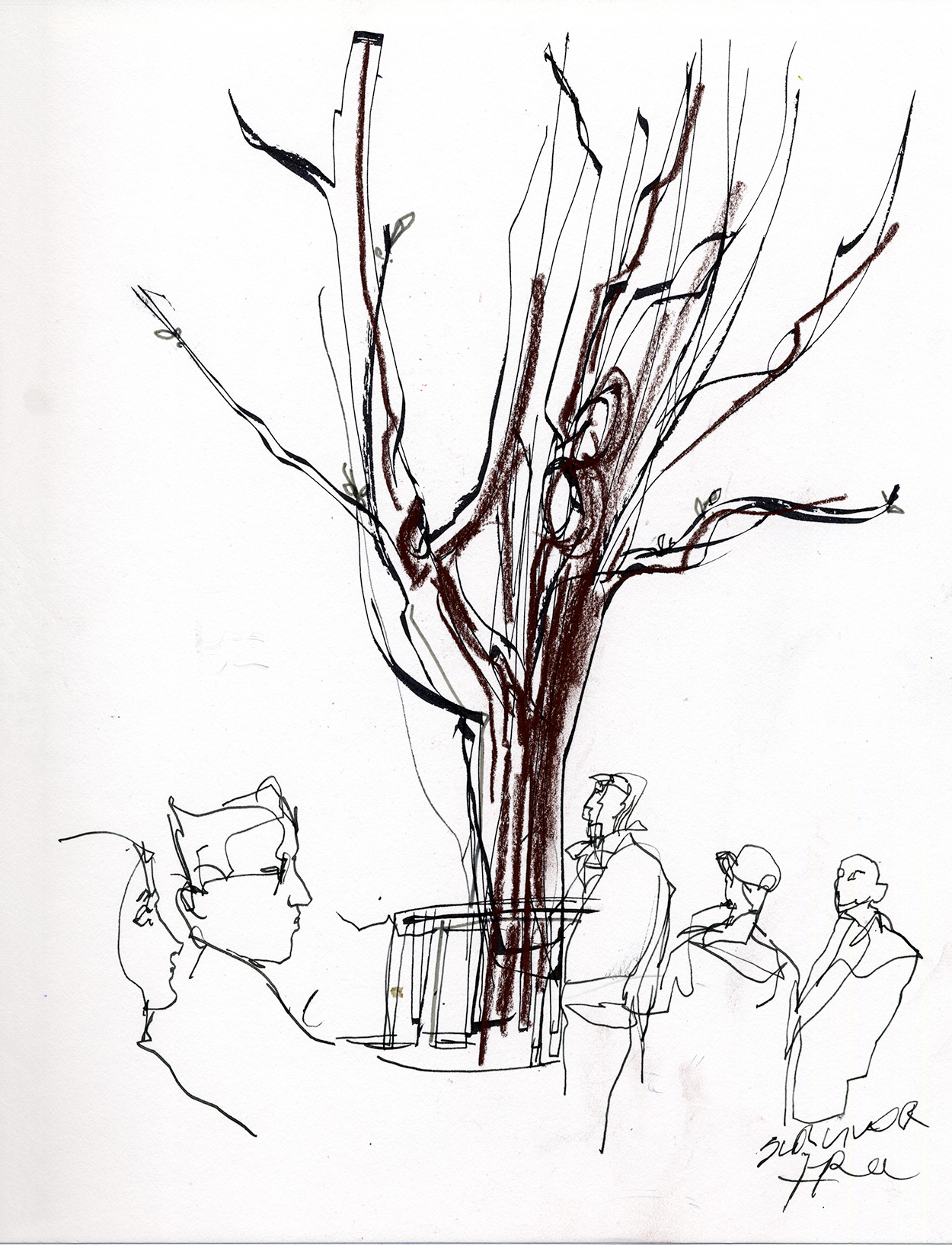
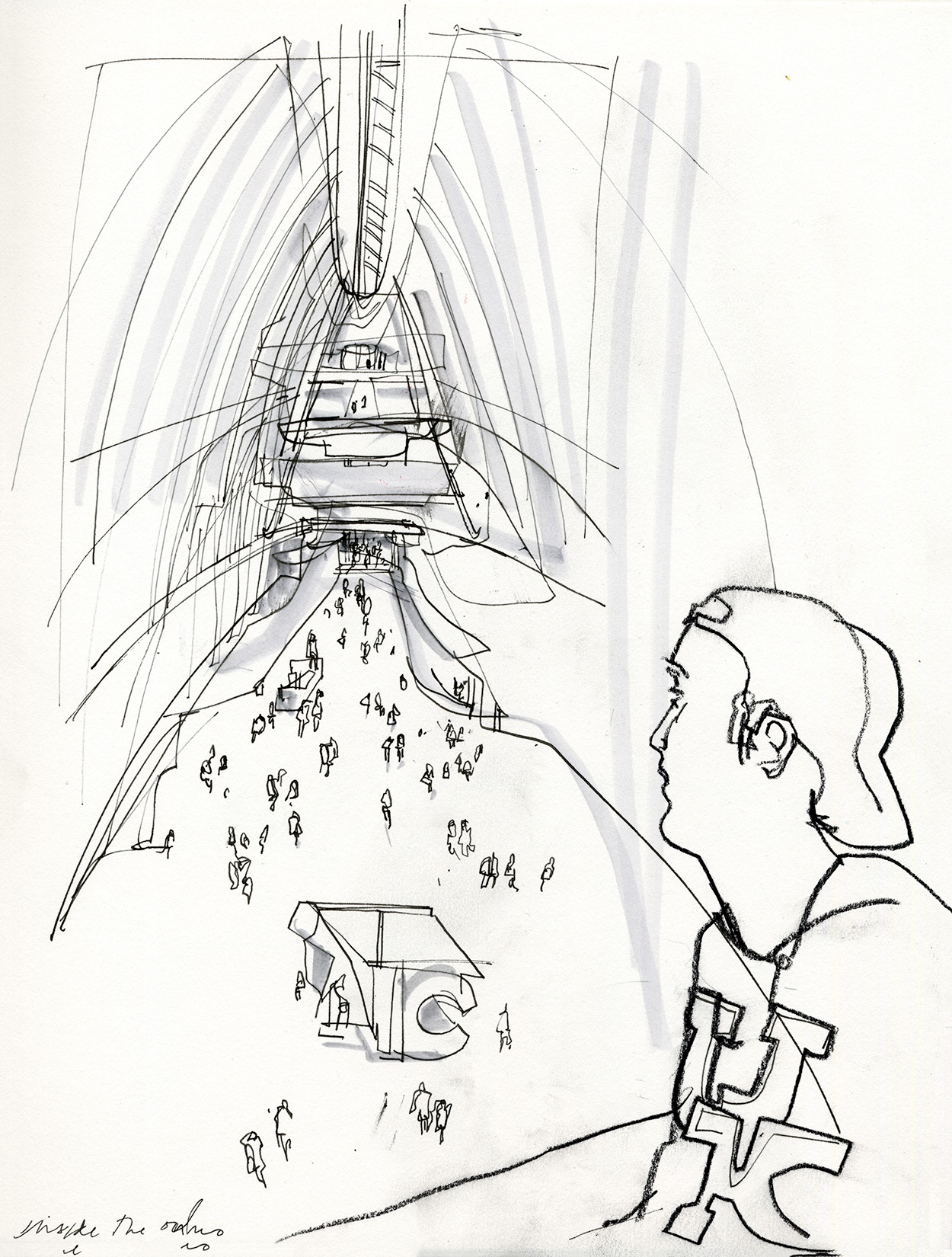
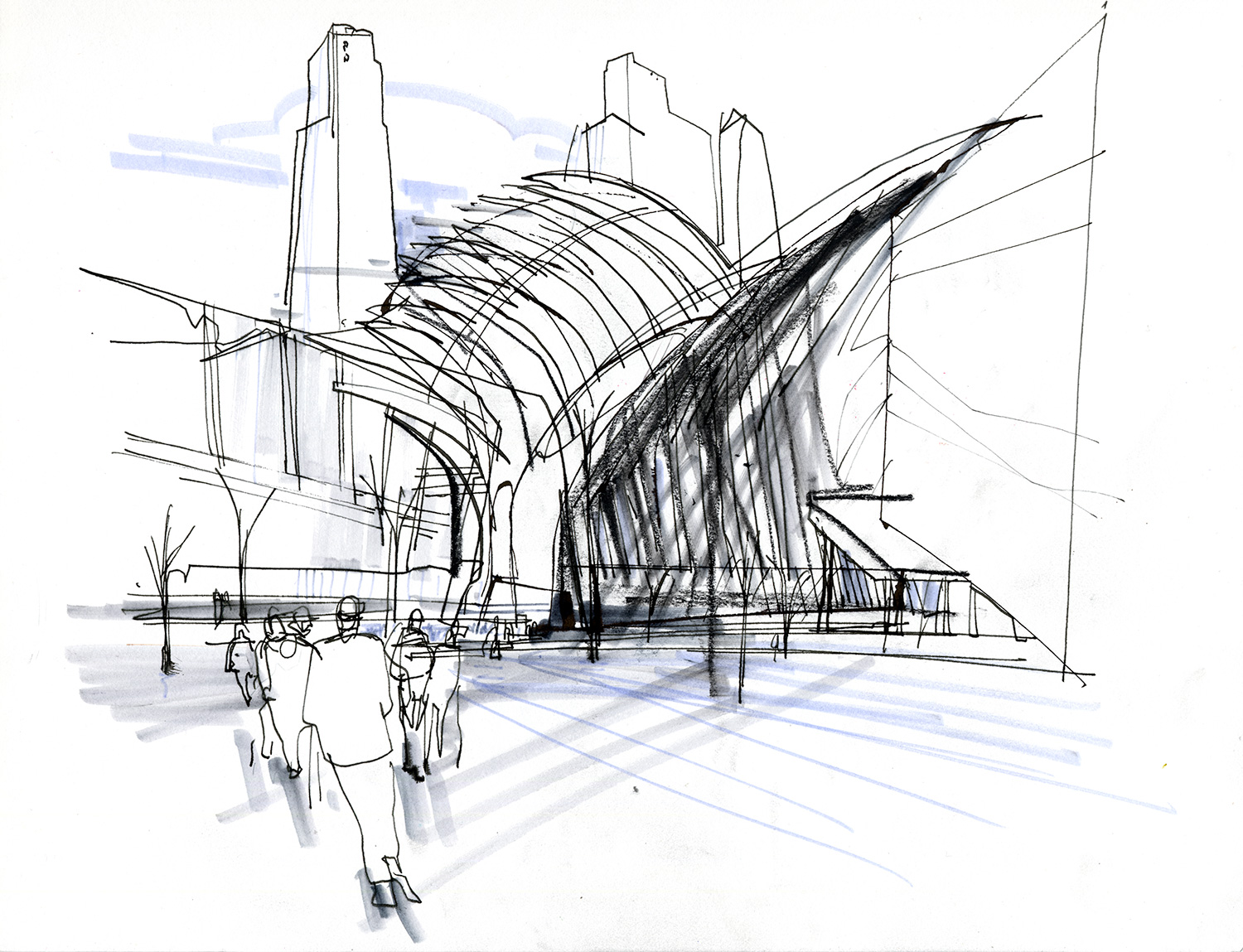
I really enjoyed this
I am an artist and LOVE to draw and paint out of my head
Great post Ronnie, I really enjoyed reading it. I felt like I was there, great work!
I really enjoyed reading this post. Very inspiring!
Thank you Beverly!
Thanks Greg, it was a fun one to do!
Thanks Joan, that’s terrific!
Veronica, this is terrific! I got chills (and teared up a bit, haha) while reading it reminiscing about the experiences that you so wonderfully captured. It was truly an inspirational journey. Thank you again so much!
What an inspiring and heart-warming story…how lives connect…how creativity expands and connects the world. Beautiful work! We must remain life-long students.
Ronnie,
I am so happy you captured our trip in a blog as well as through your illustrations- which, by the way, are amazing! It was an honor to meet you and watch you work. Thank you so much for the book, illustrations, countless subway passes, and words of wisdom. I hope to get back to see both you and NYC sometime soon.
Thank you David – it was so great to share the journey with all of you.
Yes Mary Ann, always something more to learn! xo
Thank you Amanda, I hope you get back to NYC soon! :)
Veronica: what a gorgeous post the drawings are beautiful and your observations so exquisite. I should havectagged along with you for the rest of the day and simply looked over your shoulder! I would have learned so much from you and from my friends. Thanks so much for this!
Thank you Stephen. I would have loved you to tag along! It was so nice to meet you and Gael, and have the pleasure of listening to both of your inspirational talks. Love your work.
Terrific drawings and wonderful capture of creativity. Thanks for a post that I can read again and again.
Best wishes, Frank B
Frank, thank you for your comment. I hope you’re doing well. xx Ronnie
This is so round! What an artfully designed day. Thanks so much for sharing it so generously.